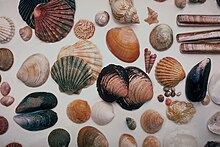Shell Island (Wales)
Shell Island , ( Welsh Mochras ) is a peninsula west of Llanbedr in Gwynedd , Wales .
history
Originally an island, Shell Island became a peninsula after the River Artro was diverted from its previous course by George Finch, 9th Earl of Winchilsea in 1819. The river flowed south of the island and the access to the settlement on the island was through the village of Llandanwg , which is now separated by the estuary .
Shell Island is known for the large biodiversity of the mussels and sea snails that wash up on the beach, as well as their wildflowers. It is said that there was a connection to the legendary " Cantre'r Gwaelod " (Welsh Atlantis).
geography
The island slides into Cardigan Bay in a crescent shape . To the south of the island there are extensive dune areas that are only separated from the actual island by the dry bed of the River Arto. In the east of the original island there is still a bay that falls dry at low tide and in the north, where the Arto flows into the sea today, forms the Mochras Harbor . Numerous paths run across the island. Vehicle access to the island is only possible at low tide via a dam through the estuary of the River Artro. The island can be reached on foot from the south via Morfa Dyffryn (Mochras beach), which stretches for several kilometers to the south. Rescue vehicles can also reach the area via the adjacent airfield.
The island is home to a popular campsite that enables so-called "wild camping". Campfires are also allowed on the beach. The island is part of the Snowdonia National Park , which is why the campsite is closed from late October to March. During this time the island is used as a sheep pasture.
geology
Mochras is a major geological research site in the UK . The area consists of a beach plateau on which the adjacent Llanbedr Airport is also located. The British Geological Survey (then: Institute of Geological Sciences) carried out a 1938 m deep stratigraphic drilling at Mochras Farm from 1967 to 1969 . Among the sediments of today's beach in the Mochras Borehole there were geologically relatively young Tertiary and Mesozoic rocks (including a strongly developed stratification of the Upper, Middle and Lower Lias - Hettangian and Rhaetian ). On the basis of this Jura layers a rejection towards the pointed Cambrian layers of Harlech -Doms. In 1971 the vertical fault was calculated to be at least 4500 m.
Individual evidence
- ↑ UKCampsite.co.uk - Caravan parks and camping sites index .
- ^ National Geosciences Data Center borehole material record from Mochras
- ^ GM Bennison, AE Wright: The Geological History of the British Isles. Edward Arnold, London 1969, ISBN 0-7131-2226-9 , p. 297.
- ↑ The Llanbedr (Mochras Farm) Borehole. IGS Report No. 71/18, HMSO London 1971, OCLC 887888085
Web links
Coordinates: 52 ° 48 '59.9 " N , 4 ° 8" 59.9 " W.


